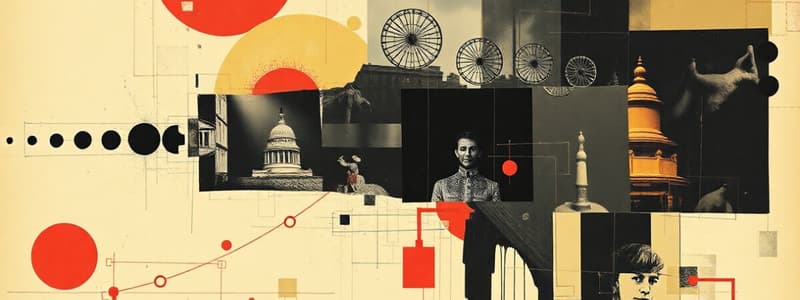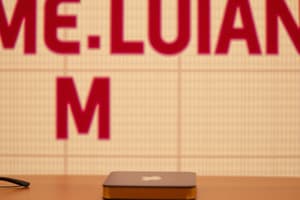Podcast
Questions and Answers
According to Turow, how do media professionals learn to portray institutional power?
According to Turow, how do media professionals learn to portray institutional power?
- Through specialized university programs designed for media portrayal of power.
- By studying the history of media representations and how they have changed.
- Through the analysis of government regulations and political discourse regarding media content.
- Through formal training and mentorship, as well as practical experience. (correct)
What is a key factor that influences editorial decisions in media?
What is a key factor that influences editorial decisions in media?
- The desire to promote specific political ideologies.
- The personal opinions and beliefs of individual journalists.
- A combination of financial, political, and organizational considerations. (correct)
- The need to prioritize sensationalized stories over informative ones.
What is the possible outcome of media professionals self-censoring to align with organizational expectations?
What is the possible outcome of media professionals self-censoring to align with organizational expectations?
- Greater diversity and representation of different perspectives in the media.
- A more balanced and impartial depiction of institutional power.
- Increased public trust in the media's objectivity and credibility.
- A potential suppression of dissenting voices and perspectives. (correct)
What is the impact of media creators internalizing industry norms for framing power dynamics?
What is the impact of media creators internalizing industry norms for framing power dynamics?
What does Turow argue is the primary function of mass media organizations in relation to creators?
What does Turow argue is the primary function of mass media organizations in relation to creators?
What is a possible consequence of the media's portrayal of institutional power influencing public perception?
What is a possible consequence of the media's portrayal of institutional power influencing public perception?
What is a potential challenge faced by alternative or dissenting narratives in reaching mainstream audiences?
What is a potential challenge faced by alternative or dissenting narratives in reaching mainstream audiences?
What is Turow's central argument regarding the depiction of institutional power in mass media?
What is Turow's central argument regarding the depiction of institutional power in mass media?
According to Turow's perspective, how does the media contribute to the perpetuation of dominant ideologies?
According to Turow's perspective, how does the media contribute to the perpetuation of dominant ideologies?
What is Turow's primary critique of the 'Four Theories of the Press'?
What is Turow's primary critique of the 'Four Theories of the Press'?
Which concept best describes the relationship between the media and external resources, as presented by Turow?
Which concept best describes the relationship between the media and external resources, as presented by Turow?
Which of the following examples BEST illustrates Turow's argument about the limits of media influence?
Which of the following examples BEST illustrates Turow's argument about the limits of media influence?
Which of the following is NOT a key element of Turow's two major trends in media analysis?
Which of the following is NOT a key element of Turow's two major trends in media analysis?
How does Turow's approach differ from the 'Four Theories of the Press'?
How does Turow's approach differ from the 'Four Theories of the Press'?
What is the primary purpose of Turow's analysis of the media?
What is the primary purpose of Turow's analysis of the media?
Which aspect of Resource Dependency Theory is most strongly emphasized in Turow's work?
Which aspect of Resource Dependency Theory is most strongly emphasized in Turow's work?
Flashcards
Media Socialization
Media Socialization
The process by which media professionals learn acceptable portrayals and topics within their organizations.
Institutional Power
Institutional Power
The influence held by organizations like government and corporations over media representations.
Editorial Influence
Editorial Influence
The impact of executives and advertisers on the content produced by media professionals.
Self-Censorship
Self-Censorship
Signup and view all the flashcards
Industry Norms
Industry Norms
Signup and view all the flashcards
Narrative Structures
Narrative Structures
Signup and view all the flashcards
Impact on Public Perception
Impact on Public Perception
Signup and view all the flashcards
Alternative Narratives
Alternative Narratives
Signup and view all the flashcards
Four Theories of the Press
Four Theories of the Press
Signup and view all the flashcards
Authoritarian Model
Authoritarian Model
Signup and view all the flashcards
Libertarian Model
Libertarian Model
Signup and view all the flashcards
Social Responsibility Model
Social Responsibility Model
Signup and view all the flashcards
Soviet Communist Model
Soviet Communist Model
Signup and view all the flashcards
Weberian Approach
Weberian Approach
Signup and view all the flashcards
Marxist Approach
Marxist Approach
Signup and view all the flashcards
Resource Dependency Theory
Resource Dependency Theory
Signup and view all the flashcards
Study Notes
Turow's Analysis of Media & Power
-
Turow's work builds on earlier theories like the Four Theories of the Press, which categorize media systems.
-
The Four Theories of the Press include authoritarian, libertarian, social responsibility, and Soviet communist models.
-
Turow proposes a more nuanced approach, recognizing media as part of broader social and economic contexts.
Two Major Theoretical Frameworks
-
Turow simplifies media theories into two perspectives:
-
Weberian Approach (Liberal Market Model): Media operates within a free-market system, driven by competition and economic incentives.
-
Marxist Approach (Authoritarian Model): Media serves the interests of powerful institutions and reinforces dominant ideologies.
-
These frameworks explain how media creators internalize portrayals of power, influenced by economic and political forces.
Resource Dependency Theory & Media's Role
-
Resource Dependency Theory suggests media organizations rely on external factors (funding, information, approvals).
-
Media influences society but is also influenced by the institutions it depends on (e.g., advertisers, government).
-
This creates a two-way interdependent system where media can challenge some aspects of society but rarely questions fundamental structures.
Media's Socialization and Institutional Power
-
Media professionals are socialized into the industry's norms regarding power portrayals.
-
Training, mentorship, and workplace experiences shape how they frame authority.
-
They often implicitly understand which institutions should be portrayed positively or critically.
-
Media decision-making is influenced by financial, political, and organizational factors.
-
Executives, advertisers, and ownership subtly or overtly shape content, leading to potential self-censorship.
-
Routine media practices become industry standards, reinforcing certain power structures.
-
Internalized norms shape how power dynamics are depicted; this impacts public perception.
-
Media portrays power influencing societal hierarchies, though alternative narratives face challenges.
Studying That Suits You
Use AI to generate personalized quizzes and flashcards to suit your learning preferences.




